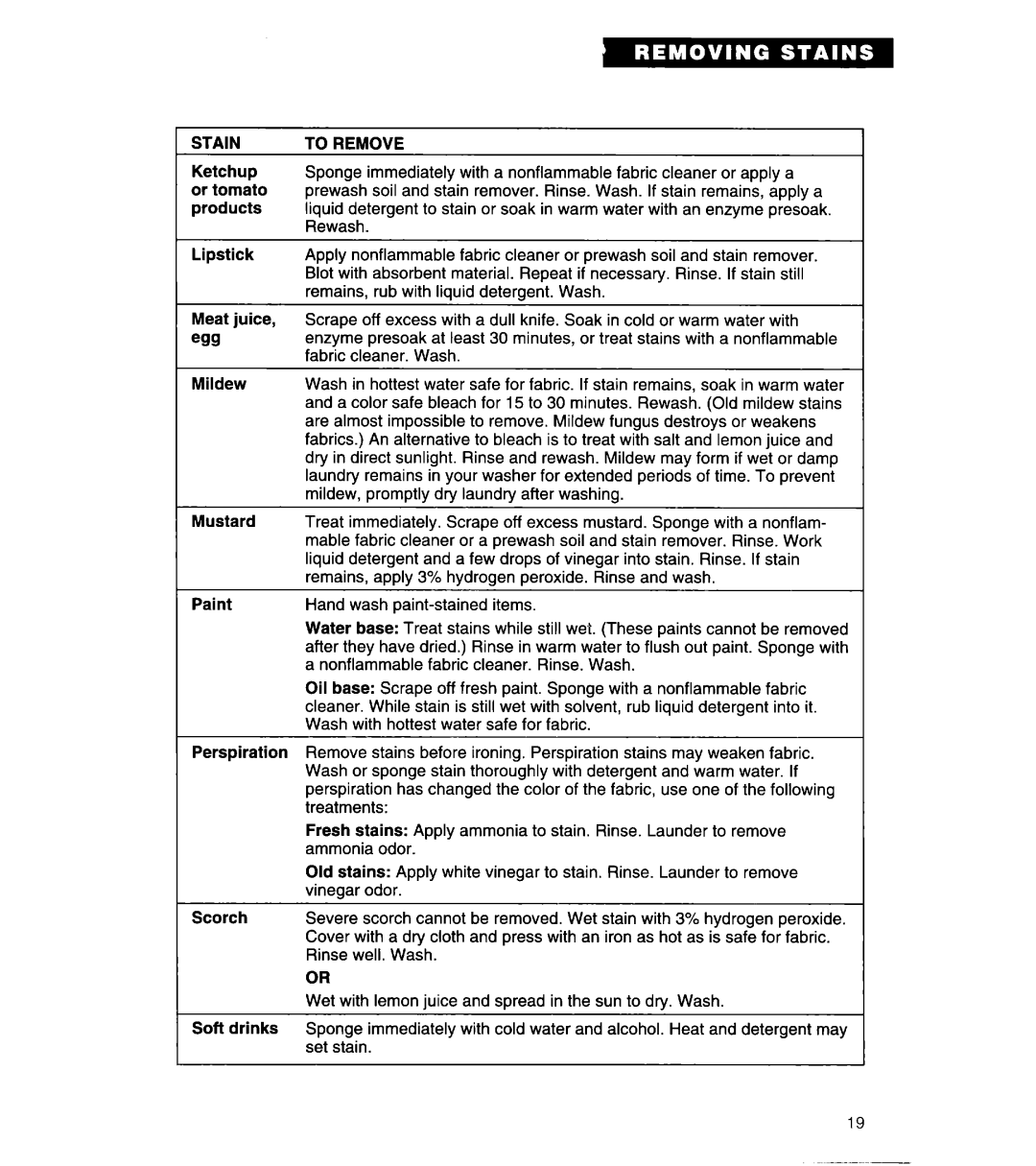
STAIN | TO REMOVE |
|
|
|
|
|
|
|
| |
Ketchup | Sponge | immediately | with a nonflammable | fabric cleaner | or apply a | |||||
or tomato | prewash | soil and stain | remover. | Rinse. Wash. | If stain remains, | apply a | ||||
products | liquid detergent to stain | or soak | in warm | water | with | an enzyme | presoak. | |||
| Rewash. |
|
|
|
|
|
|
|
|
|
Lipstick | Apply nonflammable | fabric cleaner or prewash | soil | and | stain remover. | |||||
| Blot with absorbent material. Repeat if necessary. Rinse. If stain still | |||||||||
| remains. rub with liauid deteraent. Wash. |
|
|
|
|
| ||||
Meat juice, egg
Mildew
Scrape off excess with a dull knife. Soak in cold or warm water with enzyme presoak at least 30 minutes, or treat stains with a nonflammable fabric cleaner. Wash.
Wash in hottest water safe for fabric. If stain remains, soak in warm water and a color safe bleach for 15 to 30 minutes. Rewash. (Old mildew stains are almost impossible to remove. Mildew fungus destroys or weakens fabrics.) An alternative to bleach is to treat with salt and lemon juice and dry in direct sunlight. Rinse and rewash. Mildew may form if wet or damp laundry remains in your washer for extended periods of time. To prevent mildew, promptly dry laundry after washing.
Mustard | Treat immediately. Scrape | off excess mustard. Sponge | with a nonflam- | |
| mable fabric cleaner or a prewash soil and stain remover. Rinse. Work | |||
| liquid detergent and a few drops of vinegar into stain. Rinse. If stain | |||
| remains, apply 3% hydrogen peroxide. Rinse and wash. | |||
Paint | Hand wash | items. |
| |
| Water base: Treat stains while still wet. (These paints cannot be removed | |||
| after they have dried.) Rinse in warm water to flush out paint. Sponge with | |||
| a nonflammable fabric cleaner. Rinse. Wash. |
| ||
| Oil base: Scrape off fresh paint. Sponge with a nonflammable fabric | |||
| cleaner. While stain is still wet with solvent, rub liquid detergent into it. | |||
| Wash with hottest water safe for fabric. |
| ||
Perspiration | Remove | stains before ironing. Perspiration stains may | weaken fabric. | |
| Wash or sponge stain thoroughly with detergent and warm water. If | |||
| perspiration has changed the color of the fabric, use one of the following | |||
| treatments: |
|
| |
| Fresh stains: Apply ammonia to stain. Rinse. Launder to remove | |||
| ammonia | odor. |
|
|
Old stains: Apply white vinegar to stain. Rinse. Launder to remove vinegar odor.
Scorch | Severe | scorch cannot be removed. Wet stain with 3% hydrogen peroxide. |
| Cover with a dry cloth and press with an iron as hot as is safe for fabric. | |
| Rinse | well. Wash. |
OR
Wet with lemon juice and spread in the sun to dry. Wash.
Soft drinks Sponge immediately with cold water and alcohol. Heat and detergent may set stain.
19
